Trogir Flooded Twice in 2019: Seaboard Repairs Not Enough
In ten days, repairs will begin on a damaged section of the Čiovo seaboard in Trogir. Therefore, Čiovo residents will finally have seventy meters of their damaged and destroyed seaboard repaired, but repairs won't be enough, the city's mayor warns.
Trogir is a historic town and harbor on the Adriatic coast in Split-Dalmatia County, Croatia, and has a total municipal population of 13,260. The historic city of Trogir is situated on a small island between the Croatian mainland and the island of Čiovo. It is located 27 kilometers west of the city of Split.
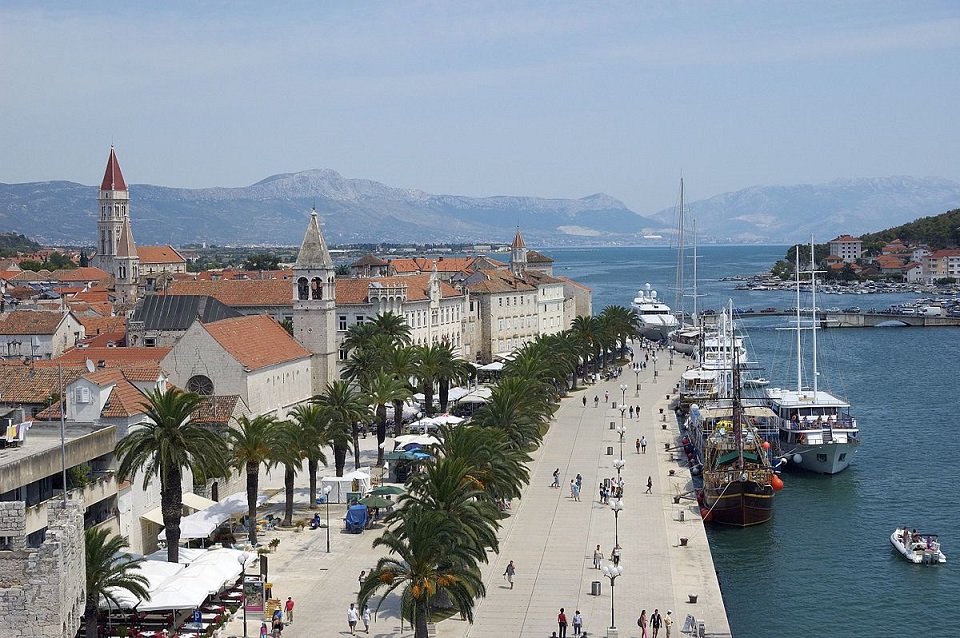
Trogir | Wikimedia Commons
The historic center of Trogir has been included in the UNESCO list of World Heritage Sites for its Venetian architecture since 1997.
“This investment is worth around 500,000 HRK (67,100 EUR). We had a problem with a ship which was illegally docked, but we have resolved it and the project should be finished in three months. In addition, we plan to make additional improvements the seaboard, port authority and town square,” said Ante Bilić, the mayor of Trogir.
Both the Čiovo and Trogir shorelines ended up underwater twice last year, in November and December. Many other Dalmatian cities have been experiencing similar fates according to HRT on January 9, 2020. Extreme windstorms (Bora), heavy rainfall and a sudden rise in sea level could be disastrous for coastal areas.
“It has happened in the past, but not as frequently. This can hardly be solved by raising the seaboard level because flooding also occurs from catchment and stormwater. We need to discuss these issues at the state level and with ministry of the environment, because this is everyone’s problem,” explained Mayor Bilić.
Scientists have been warning that sea levels could rise from 40 to 120 centimeters in the next hundred years. Without serious investment into preventative projects, the question is who will end up in the "front row to the sea."
Follow our Lifestyle page for updates on environmental concerns and the effects of climate change in Croatia.
Maslenica Bridge on A1 Motorway Closed 10 Cumulative Months Since 2008
According to data collected by Croatian Highways (HAC), the Maslenica Bridge on the A1 Motorway has been closed to traffic for 10 cumulative months since 2008. Residents of Dalmatia had believed for decades that their isolation would cease after the highway connecting them to continental Croatia was completed. They also welcomed the arrival of the Karlovac - Zadar - Split section of the A1 motorway route, including the "New" Maslenica Bridge, which officially opened on June 26, 2005.
But that good fortune only lasted until the first big storm, according to Jurica Gašpar/Morski on December 29, 2019. From then on, depending on wind speeds, the section spanning the Sveti Rok Tunnel to the Maslenica Bridge would regularly close to vehicles of all sizes in order to protect passengers.
Maslenica Bridge Closed to Traffic More Frequently
Nothing has changed since then except for the frequency of the motorway closures. For the last seven years this section has been closing even more frequently. So, 2019 will be remembered as the year it closed 68 times, which is the most it has ever been closed for traffic. By the end of this year, this section of the A1 had not seen traffic for more than 498 cumulative hours, or almost 21 days.
Courtesy of Croatian Highways (HAC), there is detailed bridge closure information from January 2008, the creation of the their database, to December 2019. During this time period, a total 575 traffic closures of the Sveti Rok - Maslenica section have been recorded, with a duration of almost 7126 cumulative hours or 297 days, which amounts to almost 10 months of traffic closures on this most delicate part of the A1 motorway.
Bora Closed Maslenica for 34 Cumulative Days in 2012
Regarding closures due to the Bora (extremely strong wind in Adriatic Coast), 2013 was the most peaceful year because the motorway closed only 29 times for almost 362 hours, or 15 cumulative days. And although the previous record for number of traffic closures the (60 in 2009) was not surpassed in 2012; the record was eclipsed for cumulative hours closed. Traffic was banned on this section spanning Sveti Rok Tunnel and Maslenica Bridge for 813 cumulative hours, or more than one month (almost 34 days).
See the table below for more details:
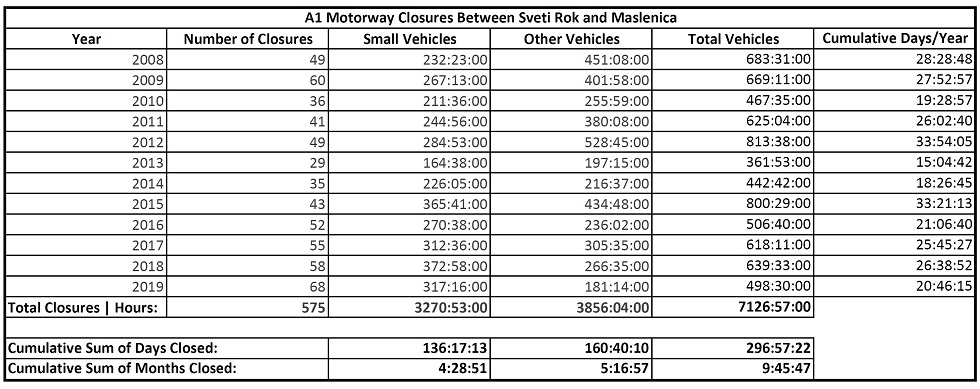
The Maslenica Bridge (called the "New Maslenica Bridge" to distinguish it from the "old" one, which was bombed during the Homeland War and rebuilt in 2004) has been subject to a great deal of public and media scrutiny because of frequent closures due to the storms.
Hurricane Force Winds Hit Bridge at Aggravating Angle
The highest Bora wind speed at Maslenica Bridge was recorded on December 21, 1998. At that time, wind gusts reached hurricane force levels of 248 km/h. Experts say the problem is that the wind does blow crossways, but at a 10-15 degree angle toward the bridge, which is an aggravating factor.
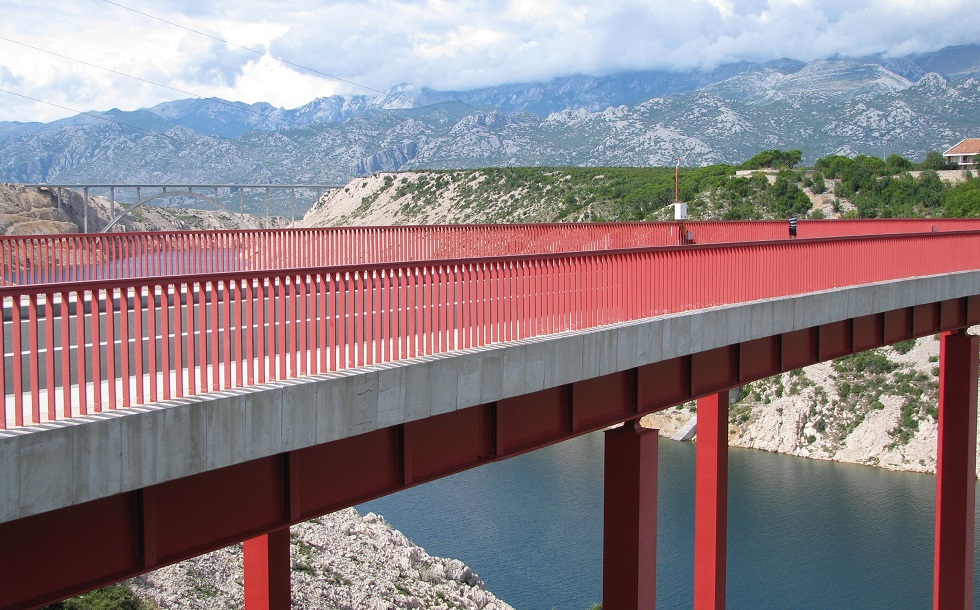
View of 'New' Maslenica Bridge from 'Old' Maslenica Bridge | Wikimedia Commons
Local Shepherds’ Advice Ignored for ‘New’ Bridge
Senior residents in the area recall that the builders of the "Old" Maslenica steel bridge on the D8 state road had inquired with locals about the best location. Shepherds reportedly responded by pointing out places where animals gathered and evacuated during the strongest winds. The first bridge was built on that site, and that turned out to be a successful choice because the Bora has hardly ever closed this bridge. The same cannot be said for the “new” bridge, of course.
Therefore, it’s no surprise that builders hadn’t taken any wind speed measurements for the area of the planned A1 motorway section spanning Sveti Rok – Maslenica before they began construction on the new bridge. Later measurements showed that this area between Marun and Crnava draga is the windiest – and that’s exactly where the highway was built. The average wind speed there is 32 kilometers per hour.
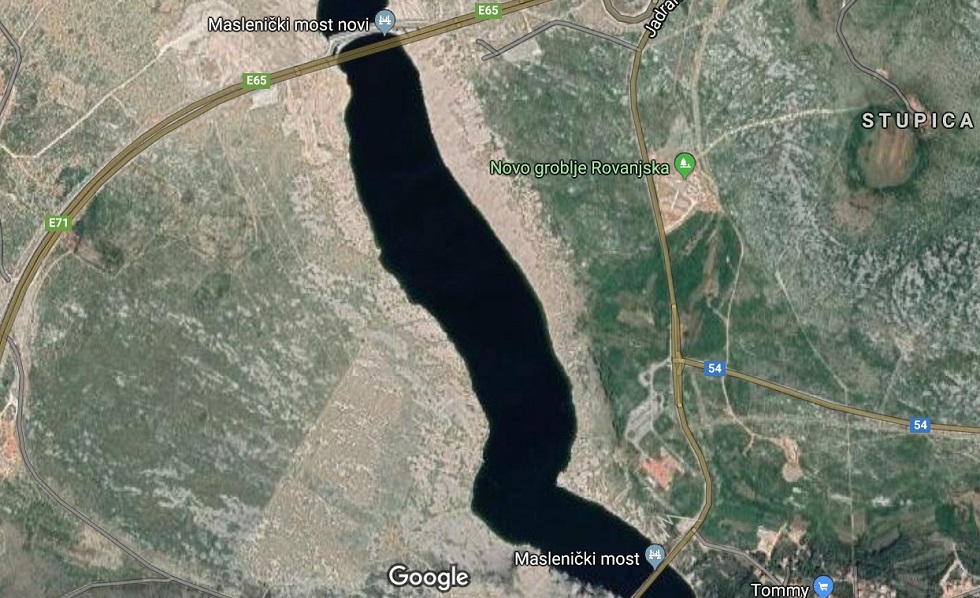
'Old' and 'New' Maslenica Bridges on Map
Most Expensive Motorway Section in Dalmatia
There is enough material to write a book about the politics, historical circumstances and (not) listening to locals and professionals regarding the planning and construction of this section, so those details will be left out of this text. Just the construction of the Sveti Rok Tunnel alone amounted to 1.5 billon HRK (20.1 million EUR), and billions were involved in building the connecting motorway over viaducts, overpasses and ultimately the Maslenica Bridge, which makes this section by far the most expensive motorway in Dalmatia. Therefore, each closure costs millions.
Suffice to say that Maslenica bridge closure has become more frequent issue and an adequate solution has not been found or implemented. But that's why Dalmatia has the most expensive toll road in Europe.
Follow our Travel page for more information, updates and upgrades on infrastructure in Croatia.
Slavonia to Dalmatia in Under 4 Hours: The A1 Motorway
The Autoput A1, a motorway which will run through Bosnia and Hercegovina, is currently under construction. It will span 334 km when completed and will be the fastest route between Slavonia and Dalmatia.
Why is the A1 important for Croatia, Slavonia and Dalmatia?
According to Google Maps, it currently takes roughly the same amount of time (7 hours) to drive from Osijek (in Slavonia) to Ploče (in Dalmatia), either by staying within Croatian borders or crossing through Bosnia. The Croatian route is a 784 km drive, while current routes through Bosnia are up to 200 km less. Nevertheless, the drive through Croatia remains on four-lane motorways, which are built for speeds of up to 130 km, while the two routes through Bosnia mostly involve two-lane roads where speed limits vary, but are capped at 80 km.
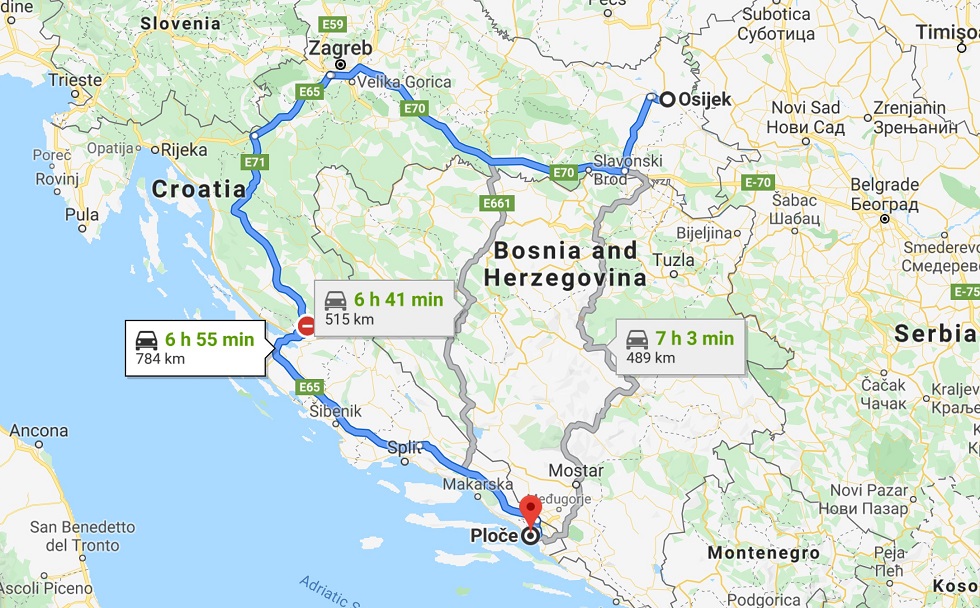
The Autoput A1, which will span Eastern Bosnia, will be an estimated 334 km in length. It is approximately 72 km from Osijek to the Bosnian border, and about 24 km from the Bosnian border to Ploče. Once the A1 is complete, it will be a about a 430 km drive from Osijek to Ploče, which is 354 km less than the current Croatian route and will take less than 4 hours!
The route also provides a faster connection from the rich agricultural region of Slavonia to the Port of Ploče, a key Adriatic port in Southern Dalmatia.
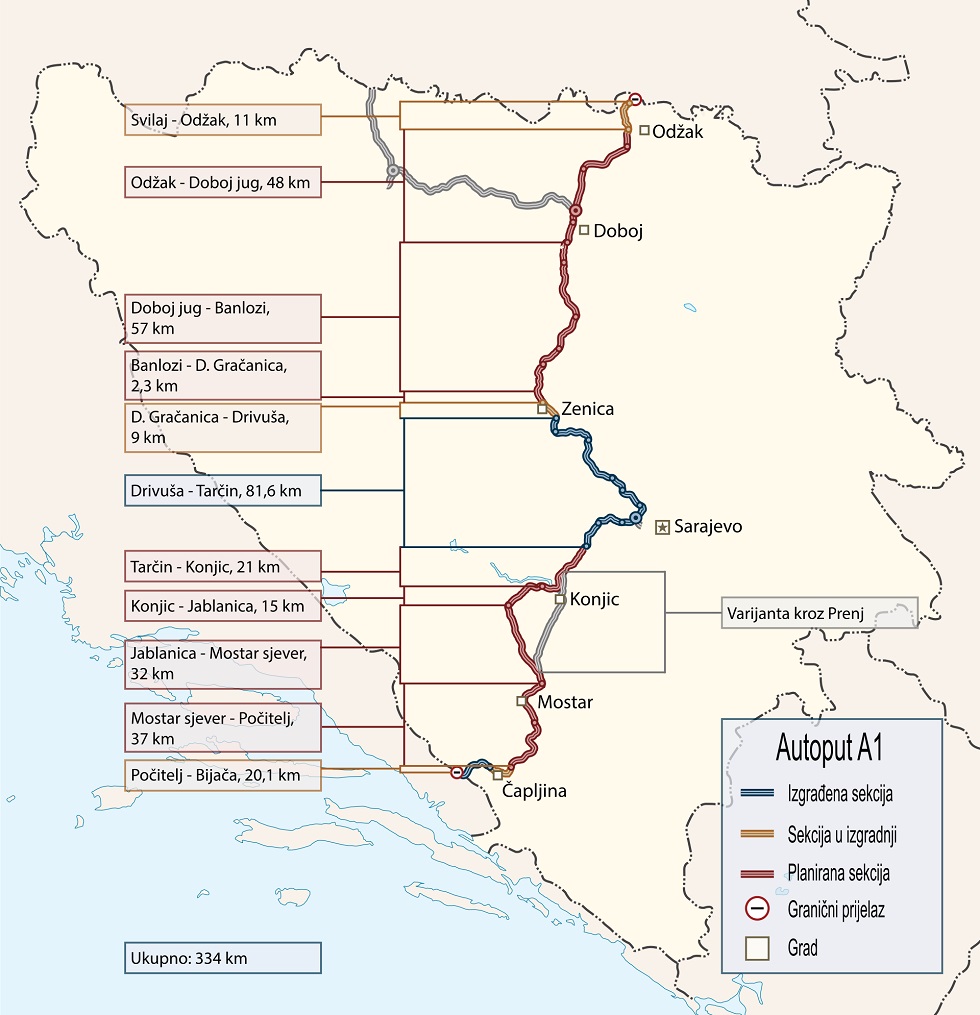
Why is the A1 important for Bosnia and the entire region?
As well as providing a connection to the Port of Ploče, the A1 will connect four major Bosnian cities: Doboj, Zenica, Sarajevo and Mostar. It also connects Međugorje, Kravice and Počitelj; all of which are world-class tourist destinations.
The A1 is part of European Route E73/Corridor Vc, which will connect the above-mentioned towns and cities to Budapest, Hungary.
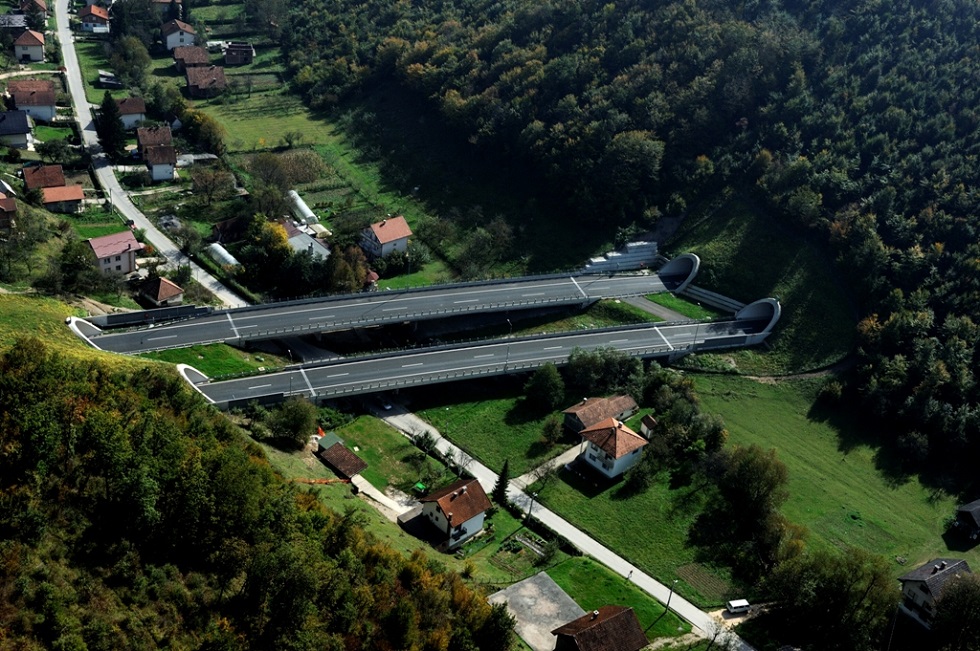
What are the environmental concerns?
The A1 highway route has been criticized by environmentalists, concerned citizens, and factions of the academic community and media for its encroachment on many endangered natural phenomenon, habitats and traditional ways of life in the Dinaric karst region.
This is especially emphasized in the region of Herzegovina where most of Bosnia and Herzegovina's karstic topography and biodiversity can be found. Planners have been addressing concerns by proposing variants to the route in the problematic sections.
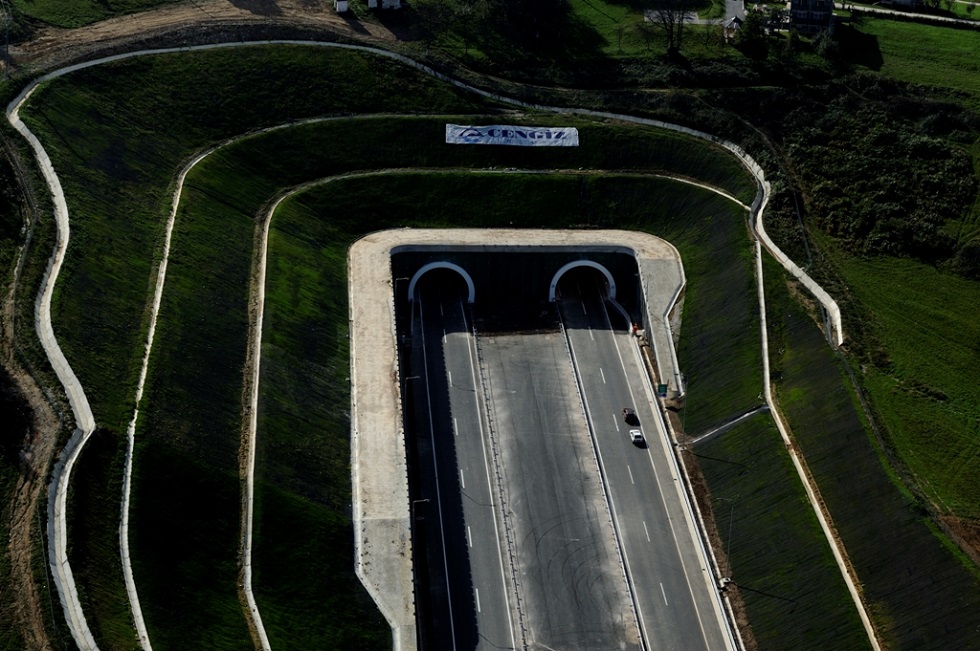
How much of the A1 has been completed? What areas are currently under construction?
About 90 km of the 334 km route have been completed so far. Those areas include an 81 km span between Drivuša and Tarčin and a 10 km span between Bijača and Čapljina.
There is 30 km of motorway under construction in the following regions: 11 km between Svilaj and Odžak and 9 km between D. Gračanica and Tarčin. The 10km between Čapljina and Počitelj, was recently contracted to China State Construction Engineering Corporation Limited and is scheduled for completion in 2021.
This means that there will be about 120 km of the 334 km route completed within the next couple of years.
Here is a video from JP Autoceste FBiH, which provides an overview of the route:
And a September 2019 video update on the section between Vranduk and Ponirak (near Zenica):
For more information and updates on the construction of the A1, check out the JP Autoceste FBiH website here.
To follow infrastructure developments and updates in Croatia and neighboring countries, follow our Travel and Lifestyle pages.
Natural Stress Relief: the Olive Harvest in Dalmatia
November 3, 2019 - Every Dalmatian has one eye on the olive grove in early November - and British sons-in-law are no exception. The natural stress relief of the olive harvest.
There are few finer things in life to be than a Dalmatinski Zet, or Dalmatian son-in-law. I have a legendary Punica, mother-in-law who takes great care of me as well as my wife and kids, and a hard-working father-in-law, or Punac, whose produce from the field has restored my faith in the quality of food after being raised on the fruit and veg of the supermarkets.
My Punac has long ago given up on the hope that his British zet would be a man of the soil such as he is, and no demands are made of me, but there is one time of year that I try my very hardest to be available with the family - the olive harvest.
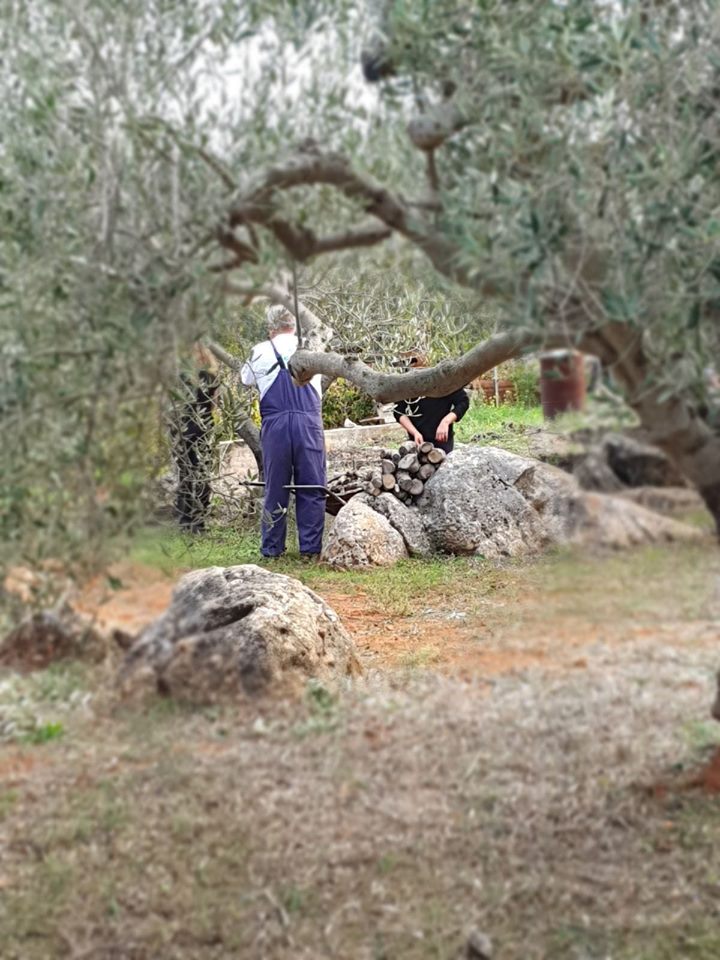
(Photo Taliah Bradbury)
In addition to all the other fresh goodness that comes daily from the family field, my Punac's 80 olive trees provide the family with enough of this precious Mediterranean liquid gold to supply the family for the entire year, and often longer. When all four kids lived at home, cheap labour was abundant for the annual pick of in excess of two tons of olives a year.
But as the kids flew the nest to university and then jobs and families elsewhere, the olive harvest became a little harder to coordinate in terms of assembling the workforce. All the kids have the harvest in mind, even if they cannot be there themselves. It is a trait I noticed in Dalmatians in Zagreb years ago - late Autumn meant olives, and successful business executives would head to the coast and islands and put on their work overalls to be at one with their olives. It is a serene atmosphere, and my daughter caught a little of the atmosphere in the video above (when she should have been picking...).
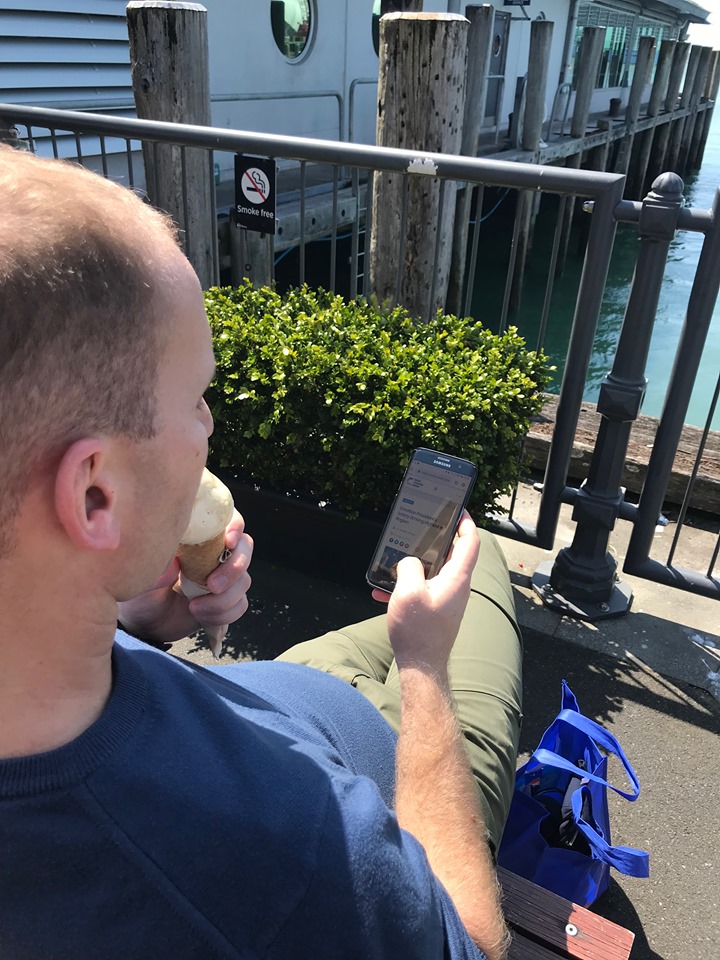
Three of the four siblings made it to the field for this year's harvest, with the other trying to claim he was with us in spirit by sending a photo of him sitting eating an ice cream on the water in New Zealand while reading Total Croatia News.
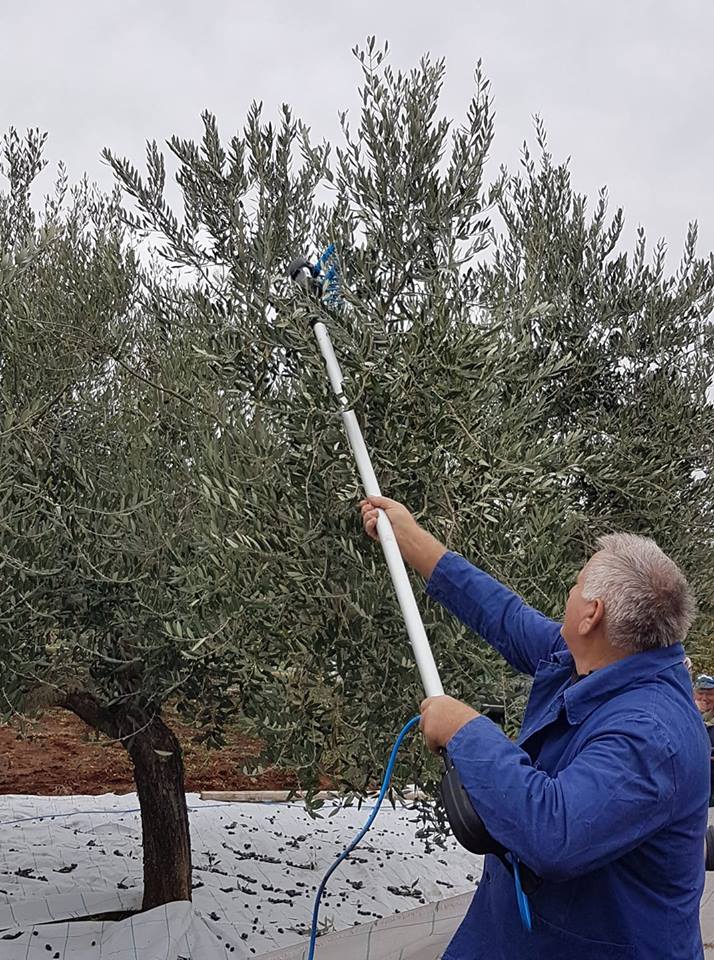
And so to work. With a less reliable pool of workers than previously, there was a major change to the olive picking lineup last olive harvest, as my Punac introduced a machine to replace the previous hand-picking 'technology' which had ruled for generations. The two-pronged machine shook the branches gently, encouraging the olives to drop to the sheet on the ground.
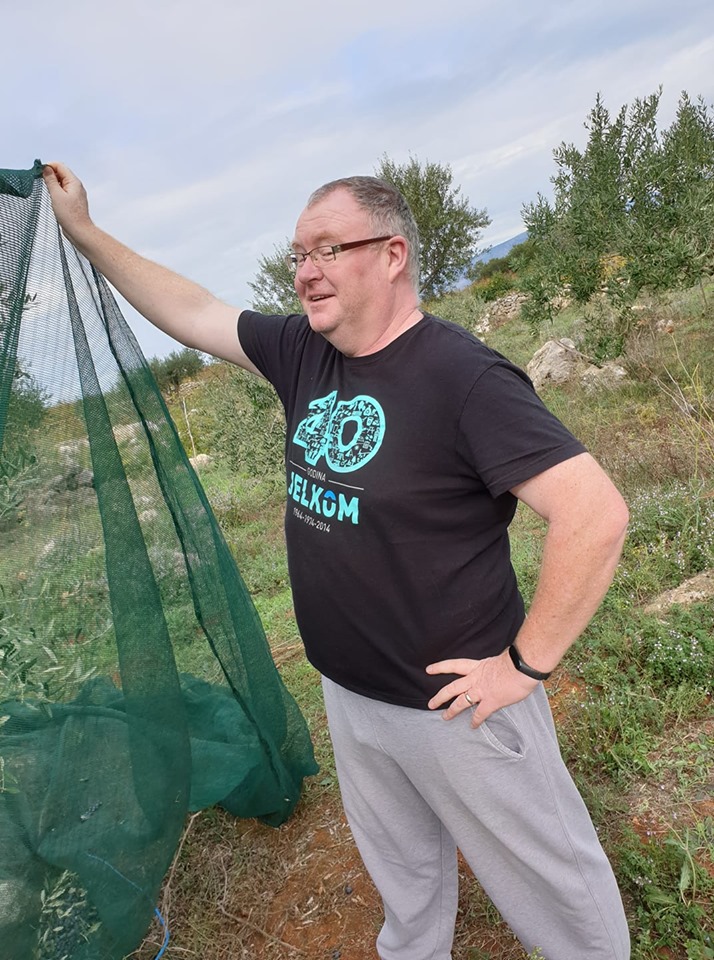
Maybe it is not a technique for the purists, but it is very effective. Not all olives drop to the ground, of course, and an important component of the support workers is to hold the net high. This is as much as act of self-preservations against flying olives hurtling to your face as an attempt to capture all of the olives. Do some olives escape the net? Absolutely. Is the picking time considerably reduced? In a way you wouldn't believe. What had been previously up to 2 weeks of picking was reduced to over two tons of olives in just over 3.5 days in early November sunshine. Final olive oil litre count is expected to be about 250 litres, more than acceptable.
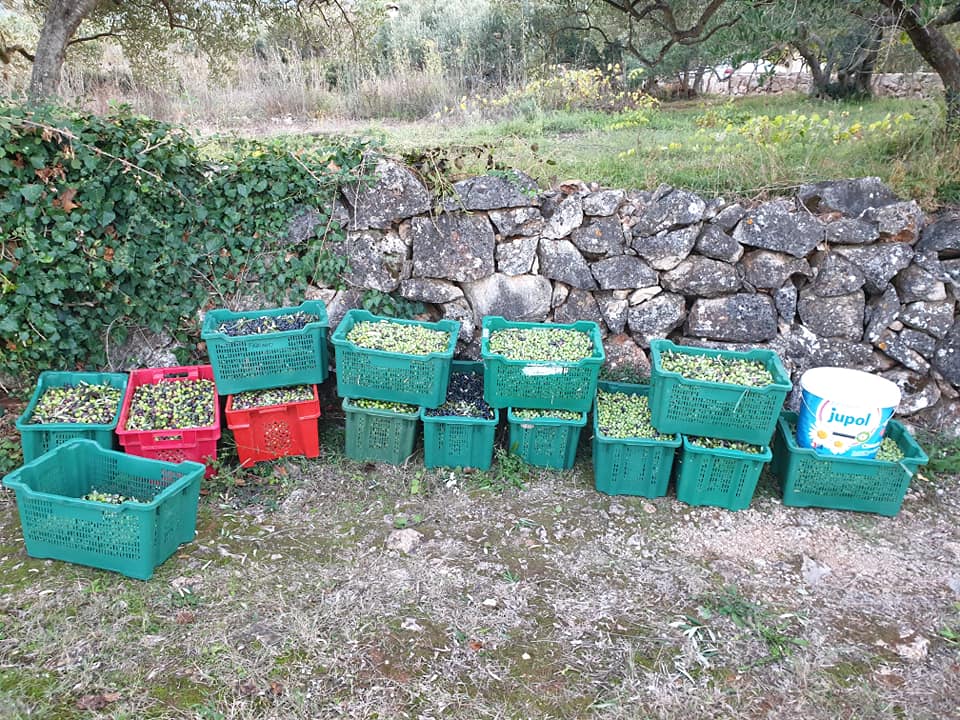
Here is the bulk of the day's olive harvest - we managed about 20 crates a day.
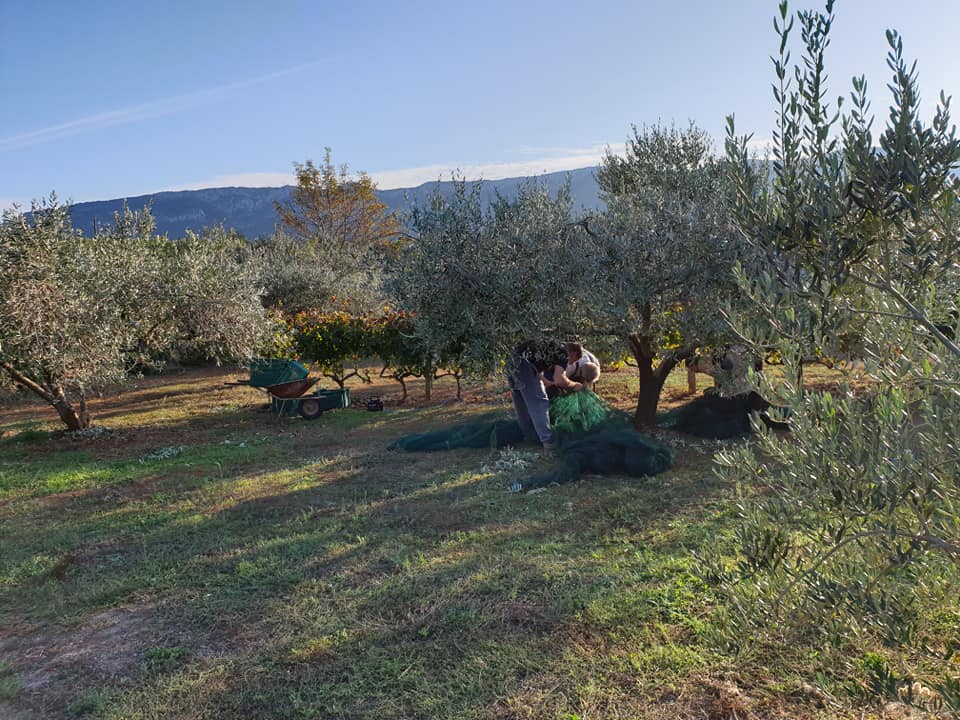
Peace. Tranquillity. Nature. Whatever your stresses elsewhere, you can leave them behind in the field. And the hand-picking technique is still required for trees which are less productive, as close to Nature as you can get.
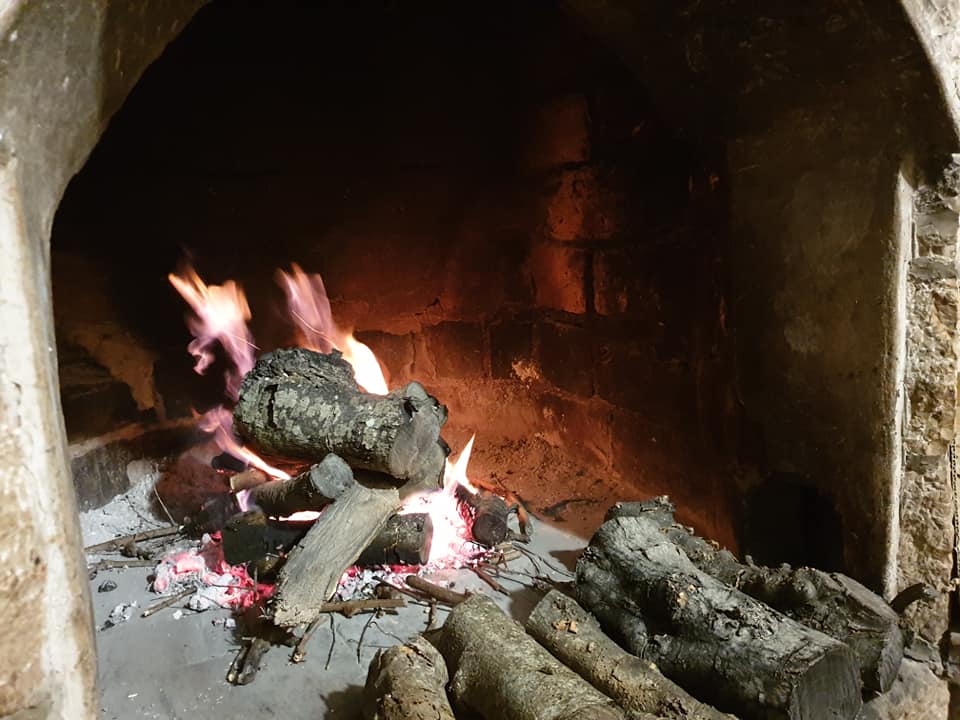
The highlight of any olive harvest, apart from picking that final olive, comes at the end of the day - rostilj! the grill!

The quality of an olive harvest lives long in the memory when measured by the quality of the feast which follows, and in this regard, my Punac never disappoints.
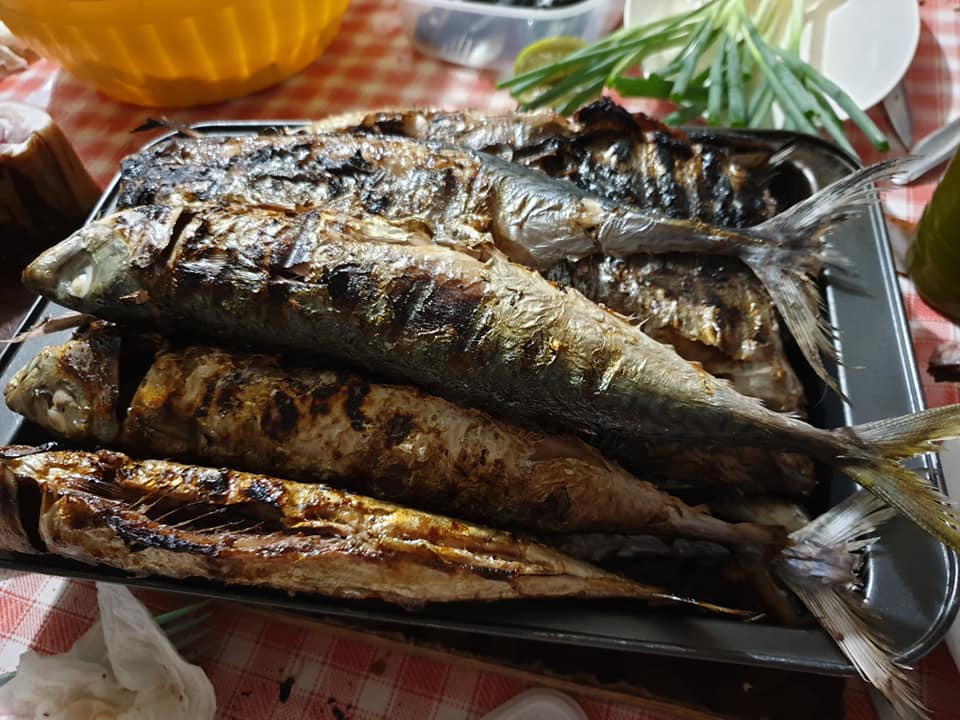
An impressive seven kilos of fresh fish, with additional sardines, were served up with salad and wine from ingredients in the field. The simple Dalmatian lifestyle at its very finest.
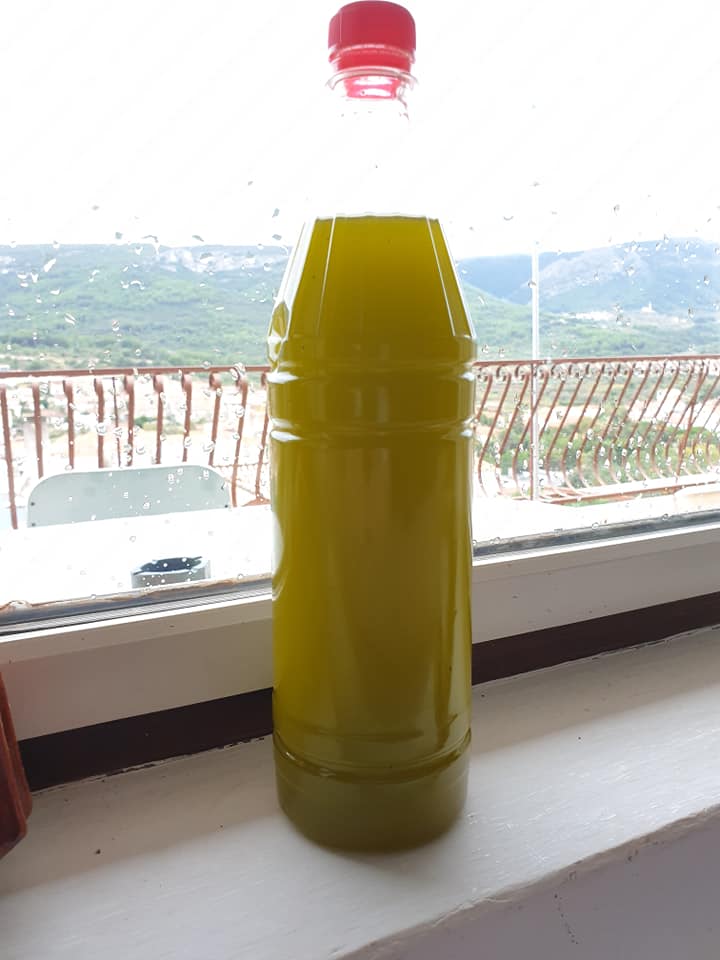
The job complete, thoughts of a return to home to our regular lives. A division of oil for the parting family, and a sigh of relief that the olive harvest timing had been so perfect. Our 3.5 days of picking in the sun were replaced with rain the following morning.
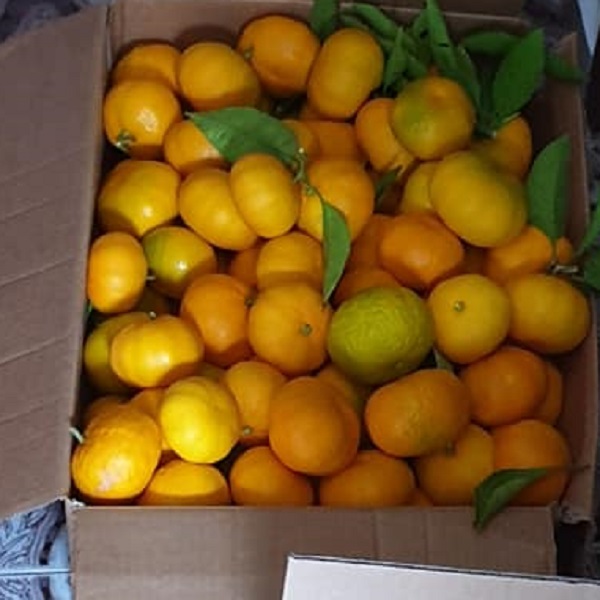
And why limit yourself to the olive grove, when there is so much goodness in the family field? Boxes and boxes of mandarins were filled from the family trees, destination Zagreb and Varazdin.
And so it came, the end of another olive harvest, and the ferry back to Split and onwards north. Thank you dear Punac and Punica, you are the best. Will see you in November 2020 in my finest olive picking attire.
PHOTOS: CroDrone Captures Incredible Aerial Images of All Saints Day around Dalmatia
November 2, 2019 - Croatia marked All Saints Day on November 1 by heading to the cemeteries to honor those who are no longer with us. A look at how the holiday was marked across Dalmatia.
You might have noticed that on Friday, much of Croatia came to a halt to mark All Saints Day, observed as a national holiday in the country. It is a day where people across the country flock to cemeteries to light candles, lay flowers, and pay respect to the loved ones lost.
It is a holiday where bus lines are rerouted to facilitate travel for those going to the cemetery, where taxi companies will offer discounted or free fares, and where many of the nation's largest shopping malls will close their doors.
Even a few days before the holiday, you'll notice locals heading to flower sellers lined along the streets, or to commercial supermarkets, to beat the rush and ensure they have the best bouquet to honor the dead.
As you can imagine, the images from November 1 are anything but bleak - and CroDrone captured just how colorful the holiday is across Croatia.
Check out how All Saints Day looked in Imotski, Imotski Poljice, Split, Runovici, Zagvozd, and Dugopolje in Dalmatia.
To read more about lifestyle in Croatia, follow TCN’s dedicated page.
Everything is Ready for the Popular Dalmatia Ultra Trail in Omiš!
As Morski writes on the 16th of October, 2019, the fourth international "Dalmatia Ultra Trail" race will be held on the 18th of October to the 20th of October, 2019. The centre of the event is the beautiful city of Omiš, which is very well known among the trekking and trail population as the "cradle of Croatian trekking".
''The race will be taking place all over the county. It goes through eleven local government units and we have three categories of races. The first and longest starts on Friday in Solin with over 150 competitors. It continues in Kaštela, Kozjak, Klis, Poljice, Zadvarje, Brela, and then ends in Omiš.
The second category (54 km) starts from the Makarska Riva on Saturday morning at 09:00. At 13:00 on Saturday, the third 18 km long race begins in Dugi Rat, and on Sunday at 11:00 there is a children's race where more than 200 children of all ages are expected to partake. This is a sport and tourism event, which promotes our entire county as an ideal destination for active tourism,'' said Dragomir Čović, a member of the organising committee.
The importance of the project was recognised by the large number of tourist boards and administrative administrations through which the race route passes, which have as such become part of the "Dalmatia Ultra Trail".
''We've been supporting the race from the very beginning. When the organisers came to me a couple of years ago, I thought, well... what does that have to do with tourism? However, when I came to the finish of the race and saw how many foreign and local visitors there were, and the enthusiasim that accompanied the race, I realised the importance of this event.
After several years, this event has become one of our county's strategic projects. The synergy of tourist and sporting events has been recognised. This is very important and necessary for tourism in the county. This race is an indispensable part of the post-season, it benefits us to attract guests who love hiking the mountains and trails. That's a huge amount of marketing being done. With this race, we're keeping up with the pace of the world and it's also an example is that with a lot of desire and work, an event at the global level can be created,'' said Joško Stella, Split-Dalmatia County Tourist Board's director.
Due to the high level of interest and the number of competitors that exceeded all expectations of the organisers, it should be noted that the entries for all three races are closed. And for all the little ones, some good news follows! Applications for a 1 km long children's race are still open, which will be held on Sunday on Omiš beach. The winners of all of the races will be announced on Sunday at 12:00.
Petra Bartulović, director of the Omiš Tourist Board, which co-organised the race, said the entire city lives for the race that weekend.
''We're glad that Omiš is becoming more and more known as a destination for sport-adventure tourism, in addition to klapa songs, pirates and soparnik. I'd like to point out that besides the amount of participants of the race, we're also pleased by the level of following, which all affects the number of overnight stays in Omiš,'' said Bartulović.
In order to make the stay in the area and the race more enjoyable for its competitors, the Dalmatia Ultra Trail Association seeks the help of volunteers who will help them with organising, logistics, arranging and marking the track, assisting at refreshment stations, paying attention to traffic where runners go, and more. In addition, numerous runners are set to arrive from distant countries, so organisers are urging the locals to come out in front of their homes, greet the competitors and present Croatia as a country of friendly, warm, and kind hosts.
The Dalmatia Ultra Trail is an international adventure project that connects the most beautiful locations of this central Dalmatian area, the most important historical and cultural monuments in the promotion of Dalmatia as a new ideal destination for outdoor activities, sport and competitions.
Make sure to follow our dedicated sport and lifestyle pages for much more.
Is Omis Traffic Misery Finally Coming to an End? Long-awaited Bypass Project Back in Action
October 3, 2019 - The well-known Omis tunnel, which has been a hot topic among everyone from locals to drivers in Dalmatia and even international media for years, could finally see the light.
"The works should start in the next month to a month and a half, and the estimated duration of these works is somewhere between two and a half, up to three years, so we expect that everything will be done within that period," said the mayor of Omis, Ivo Tomasovic for Dalmacija Danas.
The bridge over the Cetina river, tunnel, and connecting roads are part of the Omis bypass project foreseen to reduce the unbearable traffic jams and chaos that prevails at the entrance to Omis every summer.
"After a long time, we managed to revive this project in some way. Speaking from a traffic point of view, we can say that this is one of the most significant projects,” says Josip Skoric, CEO of Croatian Roads.
It is a project that has been spoken about for years but has never seen the green light for construction. The state road that runs through the city center is one of the busiest in the country. At least 50,000 vehicles pass through it daily.
The inhabitants of Omis were asked just how much this affects their lives.
"The crowds are, say, a couple of kilometers long; it is chaotic, and drivers are on their last nerves,” said Marko.
"It's a disaster, the temperature is 37, 38 degrees, and the line of traffic is 7 to 10 kilometers. I come to Omis from Dugi Rat, and I have to travel for an hour and a half, sometimes even two hours,” explained Josip.
However, the people of Omis could hardly believe that constructing a bypass would bring salvation from the crowds and ultimately relieve traffic. Another resident said he isn't convinced the traffic would come to an end: “A bypass? I think I won’t live to see the day it begins.”
"I've been waiting 30 years for a bypass. Hopefully, now that the tunnel has been made, it will encourage someone to remember that it must be done - because this is awful,” said Zlatko.
Split-Dalmatia County prefect Blazenko Boban says he understands the criticism.
"I understand the citizens, but I will say it at last. All of the stakeholders and I must continue with persistence to finally bring the infrastructure of Split and the Split agglomeration to a decent level,” he concluded.
To read more about travel in Croatia, follow TCN’s dedicated page.
Postcards from 1960s Croatian Coast, Hvar Snow Myth Revealed: Gorgeous Video
September 26, 2019 - One of the nicest videos I have ever seen of the Croatian coast - postcards from British tourists in the 1960s And the truth about a Hvar myth.
A true gem!
Summer on the Croatian coast over 50 years ago, seen through the eyes - and postcards - of British tourists sending their impressions to friends back home.
Rijeka, Opatija, Sibenik, Split, Hvar, Dubrovnik, Kotor, Budva and Sveti Stefan, as well as plenty or remote bays thrown in - a really special tour of a different era of tourism in Croatia. A real trip down memory lane for those who remember the Adriatic coast back then.
And for an added bonus, the truth behind one of the myths of life on Hvar that I have heard many versions of, but never any proof. As the sunniest island, the hotels of Hvar are said to offer a free stay if it snows - so confident are they about the perfect weather. I managed to put this to the test in February 2012 when we awoke to find the entire island covered in snow.
So, was a free stay on offer at the hotels? The answer I got back was that if it had snowed for a week, then you were entitled a free extra night. Not quite the same thing...
However, the video reveals the truth about the origins of the claim... Come stay in winter and get the following guarantees:
1. 50% reduction if it rains more than three hours between 7 am and 5 pm (imagine if this was on offer in 2019...)
2. Free stay for each snowy day
3. Free stay for each foggy day
And a free stay if the temperature drops below a certain temperature (0 degrees).
But there is plenty of GREAT footage of the destinations mentioned above and postcard commentary from an era gone by.
Enjoy!
''Podstrana Walk & Bike'' Walking and Cycling Path Largely Funded by EU
The new ''Podstrana walk & bike'' project includes new 363 metres of cycle paths and promenades along the left and right bank of the Žrnovnica river, 1,610 metres long.
As Poslovni Dnevnik/PD i VL native tim writes on the 20th of August, 2019, Podstrana has now got a first-class promenade and a bike path. The opening ceremony of the Podstrana Tourist Board saw the final conference of the Podstrana walk & bike project held, organised by Poslovni tjednik (Business week), Vecernji list and the Podstrana Municipality, presenting the recently completed project which was largely co-financed by EU funds.
During the aforementioned event, a panel discussion was heled which primarily focused on ''the importance of development of sports infrastructure for the development of tourism, the economy, and for improving the living standards of citizens".
The Podstrana Municipality's Mladen Bartulović pointed out the fact that the cycle path and promenade are part of a more comprehensive project for the coastline from the mouth of the Žrnovnica river to the Strožanac sports port, which has cost more than 18 million kuna in total.
"The coastal promenade project cost us 10 million kuna, of which 8.5 million kuna was received in grants from EU funds, while 1.5 million kuna was provided by the municipality, and we also withdrew this part from other funds. From the mouth of Žrnovnica to the Lav (Lion) Hotel, we got a beach, a car park, communal infrastructure for restaurants and other facilities; a children's playground, two sand volleyball courts, a promenade and a cycle path,'' said Bartulović.
This is all taking place in an area that was actually sandy beach around fifty years ago, however, the area was systematically devastated due to natural causes.
"That lasted until 2010, when we in the municipality adopted a plan for the landscaping of the area, and then in cooperation with the Faculty of Civil Engineering in Split, we prepared the project documentation. Danira Zanki explained that the projects of the Urban Agglomeration of Split were approved by the Ministry of Regional Development and EU Funds for the use of the ITU mechanism. Integrated territorial investment is a European Union (ITU) mechanism introduced to strengthen the role of cities as drivers of economic development.
The territorial scope of the Urban agglomeration of Split comprises seven municipalities and six cities. The Podstrana walk & bike is located in the western part of the Podstrana Municipality, and includes new 363 metres of biking trails and promenades along the left bank of the Žrnovnica river. The location of the trail is ideal for relaxation, rest and recreation, it is properly equipped with information boards, smart benches and display cabinets with charted routes.
Make sure to follow our dedicated lifestyle page for much more.
Most Expensive Hotels, Highest Occupancy Recorded in Dalmatia this Summer
August 20, 2019 - Hotels in Dalmatia achieve the best results after experts analyze the success of hotels in Croatia for Slobodna Dalmacija.
“Hoteliers did well in the first half of the year according to all available data, and according to the announcements, this trend continues in July and August. I think 2019 will be a very good business year for hoteliers in terms of revenue, and those with 4 and 5 stars did better in the first six months of this year than last year.
The specificity of this peak season is that it is asymmetrical, it has shifted in 15 days in terms of time, business and traffic for a lot of reasons, but it will not significantly affect the operation of hotels. There is a trend that 4 and 5-star hotels are doing fantastic, and those who are worse off and have not seen an investment are operating in a market that is looking for lower prices, so their financial results are significantly worse. Because you cannot get a customer with higher-spending power if you have poor quality,” says professor Zdenko Cerović, a Ph.D. from the Faculty of Tourism and Hospitality Management in Opatija, who co-authored the Benchmarking (Business Analysis) study of the Croatian hotel industry until the beginning of July this year.
Together with him, hotel operations in the first part of this year were also analyzed by Dr. Sandra Janković and Sonja Hvaliček.
The material analyzes the operations of 114 Croatian hotels from all coastal regions and the continental part of the country, with a total of 23,500 rooms, which is more than 40 percent of the total hotel capacity in Croatia. Data on occupancy, prices, revenues and earnings were found for 25 hotels in Istria, 26 in Kvarner, 46 in four Dalmatian counties and 17 continental hotels. Key revenue management indicators by region say that in June alone, as in the first six months of this year, hotels in Dalmatia are doing the best.
In June, they achieved an average price of 139 euro per room, which is 15 euro more than hotels in Istria and almost 40 euro more than hotels in Kvarner. Also, the total income per night in hotels is the highest in Dalmatia - in June, it was 103 euro per night, which is 16 euro more than the average of Croatia. In the same month, the income in Istrian hotels per night was 80 euro, while in Kvarner 77 euro, according to the data.
“Such financial results are completely logical given that Dalmatia has a long season and good prices in hotels, and a great deal has been invested in hotels in Zadar, Šibenik, the Split region, the Makarska Riviera, and the islands to Dubrovnik. Dalmatia has made a step up in the quality of its hotel offer in a number of hotel houses, followed by good prices, the growing season, and good income. Since April, the monthly accommodation revenue per available hotel room in Dalmatia has been the highest in the country due to the highest average room rates,” explains Cerović of this year's hotel business in Croatia.
Asked if the revenue of hotels would be affected by the fact that part of their capacity was put into "last-minute" sales at lower prices due to slow sales, Cerović replied that this would not affect the hotel’s income because it didn’t happen often enough to affect their earnings.
“Although the story of the need to invest in quality in our tourism is already known, all the way to birds on branches, nevertheless, the exact data best confirm how significant the value for money is in revenue. Specifically, revenue management indicators by the category of the hotel in the survey show that total revenue per night is by far the highest in 5-star hotels, reaching 154.20 euro per night in June. At the level of all six months, it is 114 euro per night, and for comparison, the revenue per night in 4-star hotels in June was 80 euro, while in 3-star hotels it was 49.5 euro. And the average room price also depended on the category of accommodation, so in June, 5-star hotels sold for 206 euro on average, 4-star hotels had an average price of 103 euro, and 3-star hotels in June had an average price of 67.4 euro.
This does not mean, of course, that Croatia should have only the highest category hotels, but the 3-star hotels must be modernly decorated, equipped and renovated, and thus can achieve better prices and higher revenues in its category, experts say. Guests want to know that they have not overpaid, and everyone goes into a financially monitored category and looks for the best service for that category. Nobody can say today ‘it doesn't matter what kind of hotel I am, I will always have guests’, because that is no longer the case, as the financial results of investing in hotels and resting on laurels show best. "
To read more about travel in Croatia, follow TCN’s dedicated page.


